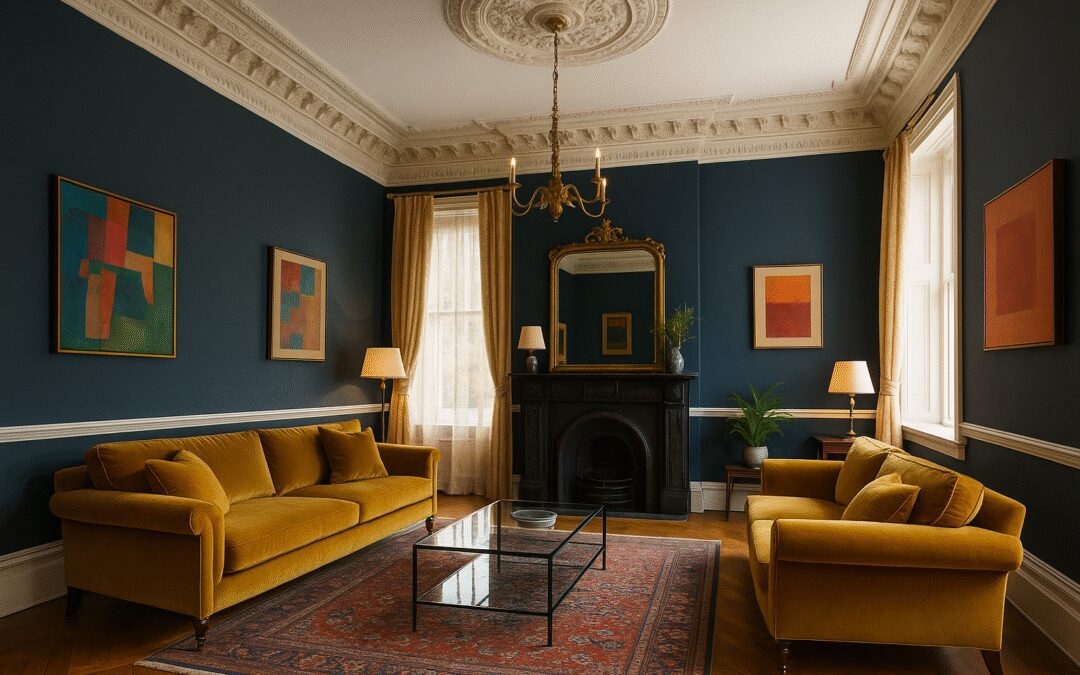Transforming a Victorian living room in Edinburgh is a true art — it’s about honouring the building’s heritage while introducing a fresh, modern spirit. The right colours can completely revitalise a classic interior, creating a space that feels both timeless and alive. With thoughtful attention to detail, it’s possible to blend period features with a contemporary edge. Here’s how to bring that balance to life.
Key Takeaways
- Use deep jewel tones such as emerald green or royal blue to bring a sense of luxury to your Victorian living room transformation.
- Combine original architectural details with clean, modern furniture for a look that’s fresh yet timeless.
- Choose rich, muted paint colours with quality finishes to highlight the character of the room.
- Work with skilled decorators and craftsmen to restore intricate details, ensuring heritage and modern style go hand in hand.
- Add personality through cushions, soft furnishings, and greenery for a lively contrast against classic features.
The Art of Restoring Victorian Living Rooms in Edinburgh
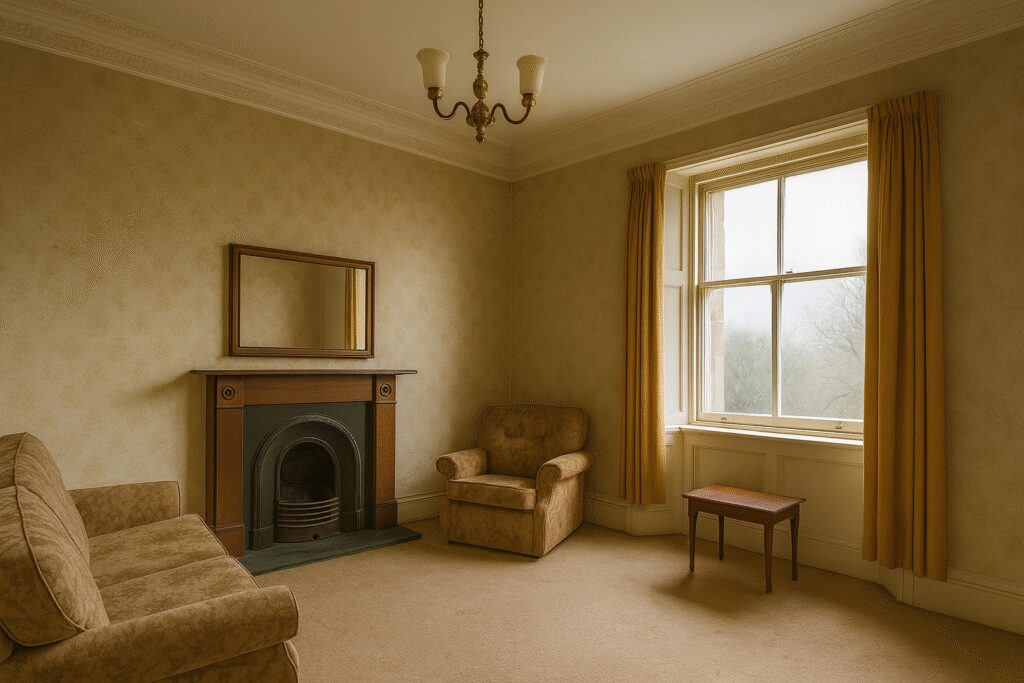
Restoring a Victorian living room means understanding the building’s character — and then enhancing it with a modern twist that feels right at home in Edinburgh’s historic setting. When done well, it celebrates craftsmanship while introducing warmth, comfort, and personality.
Understanding the Character of Period Interiors
The beauty of a Victorian interior lies in its detail — those elegant cornices, decorative ceiling roses, and grand proportions. To restore such a room successfully, it helps to really study its bones.
- Architectural Features: Keep original mouldings, fireplaces, and plasterwork wherever possible. These are the elements that give your home its unique charm.
- Colour Palette: Victorian interiors suit rich, muted tones — colours that feel deep and comforting yet still elegant.
- Fabrics and Furnishings: Choose textiles with texture and pattern to complement the period style while keeping a sense of modern refinement.
Balancing Heritage and Modern Design
A successful Victorian living room redecoration in Edinburgh strikes the right balance between preserving history and creating a space you’ll love to live in.
| Heritage Elements | Modern Design Touches |
|---|---|
| Original mouldings | Sleek, minimalist furniture |
| Antique lighting | Bold, colourful accents |
| Classic colour palette | Clean geometric patterns |
| Vintage fabrics | Streamlined finishes |
| Statement art pieces | Discreet technology integration |
Choosing Colours That Honour Victorian Elegance
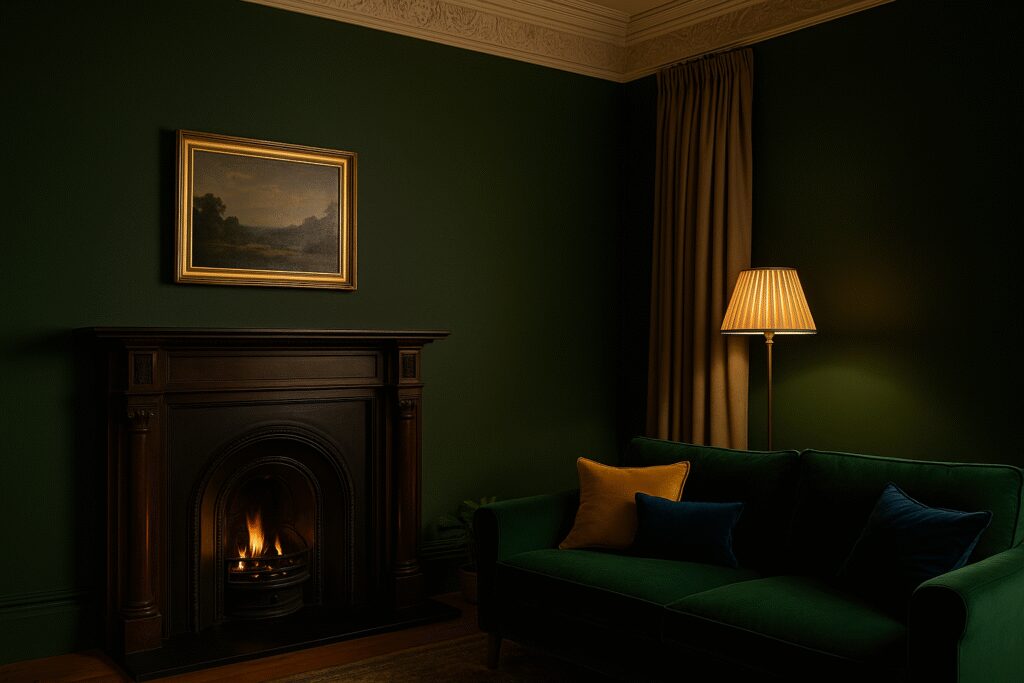
Colour plays a vital role in setting the tone for a Victorian living room. Deep, rich hues can emphasise the character of the space, while softer neutrals and contrasts help it feel warm and inviting.
Using Rich Tones and Subtle Contrasts
To bring your Victorian living room to life, pair bold tones with balance and restraint.
- Deep Jewel Shades: Emerald, navy, and burgundy evoke the grandeur of the era while adding a modern sense of drama.
- Warm Neutrals: Soft creams and greys complement these deeper tones beautifully and help to ground the design.
- Textured Finishes: Consider wallpapering or specialist painting techniques that create gentle depth and movement on the walls.
These choices will ensure your living room feels both classic and contemporary, with the depth and warmth that define Victorian homes.
How Lighting Influences Paint Choice
Lighting changes everything. Natural light, especially in Edinburgh’s softer climate, can alter how colours appear throughout the day. Always test your chosen shades on different walls and in different light conditions.
Daylight will highlight cooler undertones, while evening light brings out warmth and depth. For traditional spaces, heritage shades of green, blue, and terracotta work beautifully under both.
The key is to sample before you commit — this small step makes all the difference in achieving a truly timeless finish.
Techniques for Flawless Walls and Ceilings
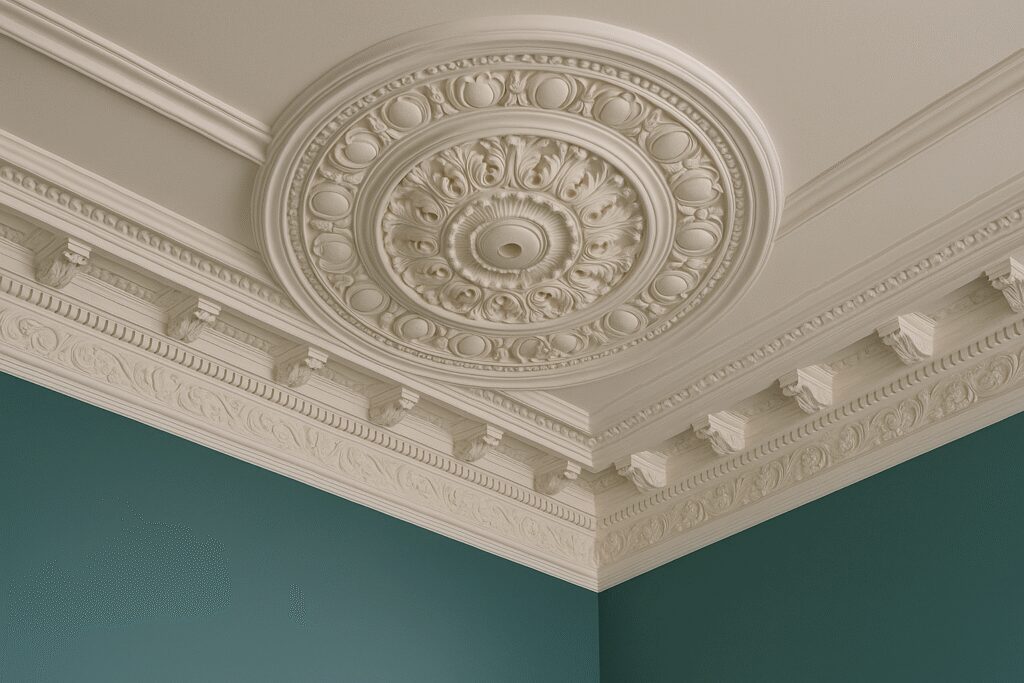
Impeccable preparation is at the heart of every successful decorating project. When working on period plasterwork, quality preparation ensures your walls and ceilings look flawless and last for years to come.
Lining, Filling, and Preparing Period Plasterwork
Original plasterwork gives a Victorian home its authenticity, but it often needs care to restore it to its best.
- Assess and Repair: Look for cracks or signs of dampness and treat them early.
- Clean and Prepare: Strip back gently to reveal a smooth surface without damaging the original material.
- Fill and Line: Use premium fillers and lining paper to create the perfect canvas for painting.
At Bert’s Decorating, our team takes pride in preserving original details while achieving a refined, durable finish that enhances the home’s history.
Paint and Finish Options That Last
The right paint and finish not only define the room’s look but also protect your investment. Opt for breathable, high-quality paints suitable for older walls. Satin or eggshell finishes add subtle elegance while resisting scuffs and wear. For ceilings, a matte finish helps reflect soft light evenly across the room. Choose colours that complement the era — muted greens, soft whites, and gentle blues all echo Victorian charm while feeling beautifully current.
Bringing the Room to Life With Details
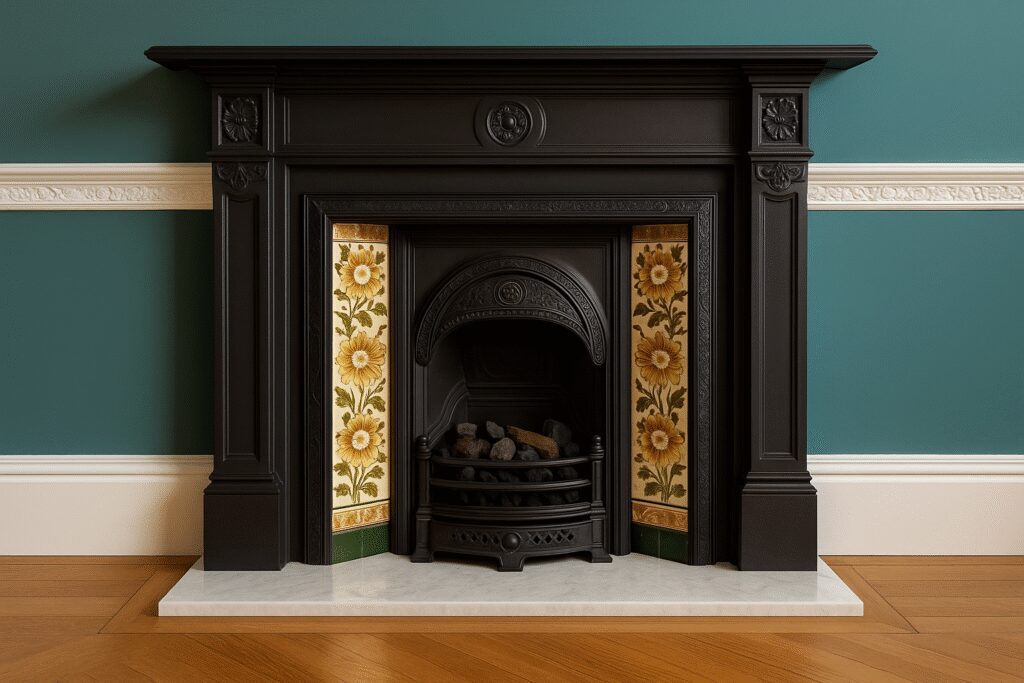
It’s the finishing touches that turn a restoration into a masterpiece. Every trim, cornice, and ceiling rose tells a story — and when restored with care, they become the true stars of the space.
Trim, Cornice, and Ceiling Rose Restoration
These architectural details define a Victorian living room. To revive them properly:
- Assess the Condition: Identify where age or damage has taken its toll.
- Use Authentic Materials: Choose plaster or timber that matches the original craftsmanship.
- Trust Skilled Hands: Restoring intricate details takes patience and experience — and it’s worth every moment when the result glows with heritage charm.
Flooring and Fireplace Considerations
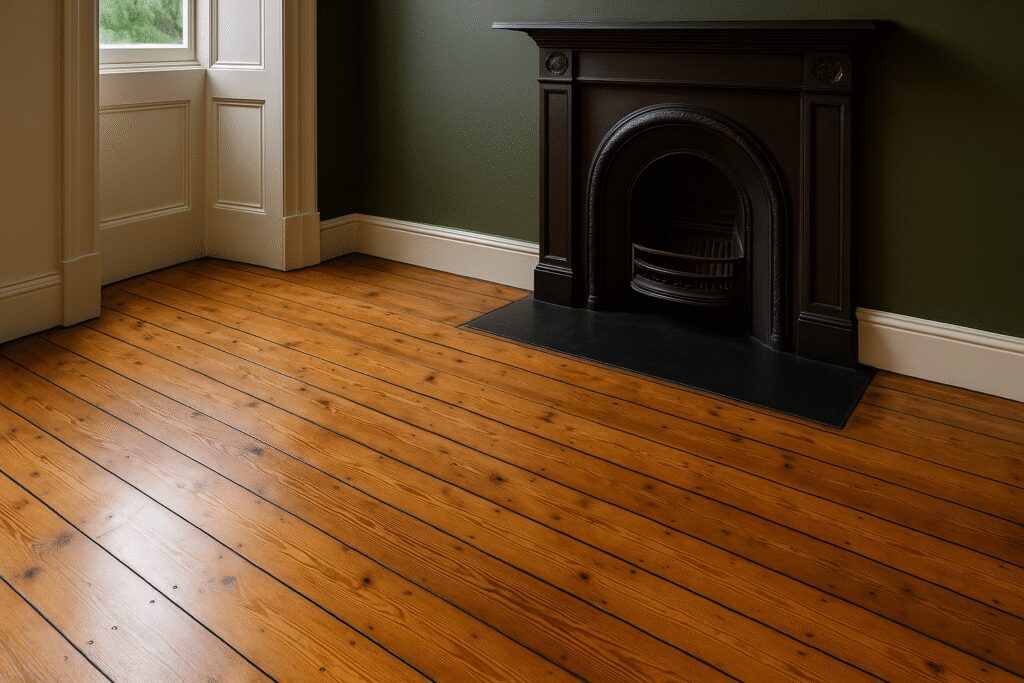
Flooring and fireplaces bring balance and warmth to the room. A restored wood floor adds richness and texture, while a statement fireplace grounds the space and creates a focal point.
| Flooring Options | Fireplace Styles | Finishing Touches |
|---|---|---|
| Original floorboards | Cast iron inserts | Decorative mantels |
| Engineered oak | Marble surrounds | Heritage accessories |
| Luxury vinyl | Wood-burning stoves | Textured rugs |
| Wool carpet | Electric fires | Soft lighting |
Case Study – A Victorian Living Room in Edinburgh
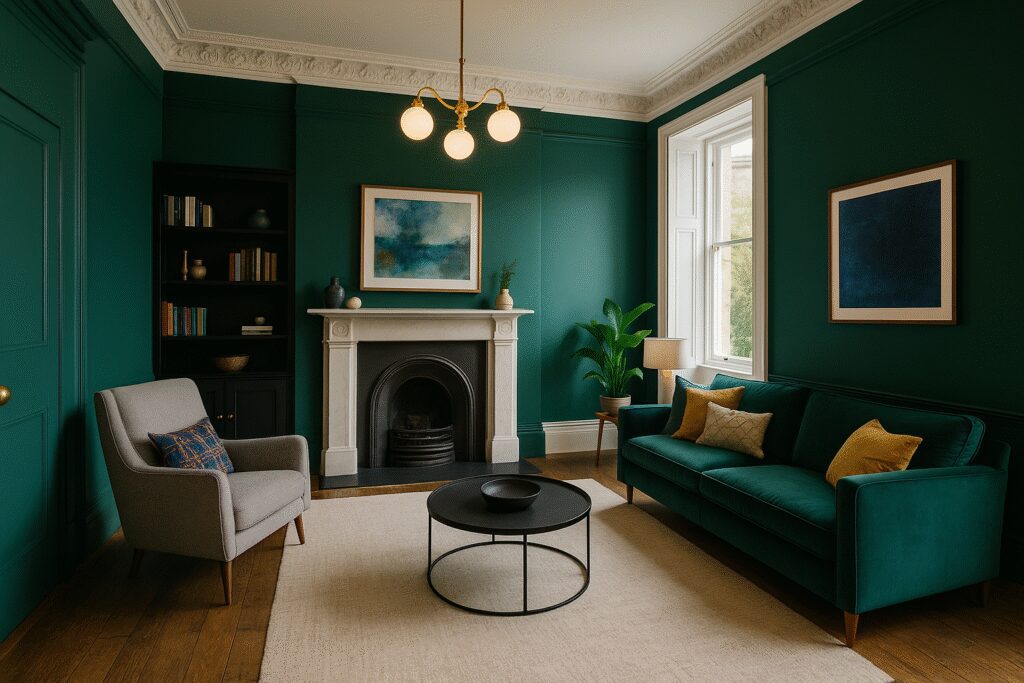
Picture a living room that once felt tired and uninspired. Through careful restoration and creative design, it’s transformed into a warm, elegant retreat full of character.
Before and After: From Dull to Distinctive
Every transformation tells a story. Here’s what made the difference:
- Furniture: Classic lines with modern comfort — pieces that respect the home’s proportions.
- Lighting: Elegant chandeliers and wall sconces replaced dated fittings.
- Textiles: Luxurious fabrics and layered textures brought colour and depth back to the space.
The result is a room that feels welcoming, distinctive, and full of life — perfectly at home in the heart of Edinburgh.
Choosing Colours and Finishes That Last
Longevity is key. Victorian spaces suit colours with depth — olive greens, terracotta reds, soft blues — paired with finishes that can withstand everyday living. Matte or eggshell paints provide a timeless look, while a slightly glossier finish on woodwork highlights the craftsmanship of doors, skirtings, and mouldings.
Maintenance Tips for Period Homes
Maintaining a period home doesn’t have to be daunting. A little seasonal care goes a long way in keeping your painted surfaces and finishes looking beautiful year after year.
Seasonal Care for Painted Surfaces
- Dust Regularly: Use a soft cloth to avoid dulling the finish.
- Inspect for Wear: Cracks and chips appear naturally over time — touch them up promptly.
- Clean Gently: A mild soap solution will keep surfaces fresh without stripping the paint.
These simple habits will help your Victorian living room remain elegant and well-kept.
How to Refresh Without Full Redecoration
Sometimes a few small updates can make a big difference. Replace cushions, throws, or lampshades for a quick style refresh. Repaint skirting boards or window frames to sharpen the look, or rearrange furniture to create better flow. And never underestimate the impact of a few healthy plants — they bring life, colour, and calm energy into classic interiors.
Frequently Asked Questions
What Are the Costs Involved in Redecorating a Victorian Living Room?
Most Victorian living room redecorations range from around £1,500 to £5,000, depending on materials and the scale of restoration. If your home requires extensive plaster or woodwork repair, costs can be higher — but quality craftsmanship ensures the work lasts for decades.
How Long Does a Typical Victorian Living Room Transformation Take?
Typically, around two to four weeks. It depends on preparation time, drying, and the level of detail involved. Taking the time to get it right ensures a flawless finish and lasting results.
Can I DIY Some Aspects of the Redecoration?
Yes — painting or styling elements can be done yourself. However, for heritage plasterwork, wallpapering, or complex colour schemes, it’s worth hiring professionals who understand the period details and materials.
What Materials Work Best in a Victorian Home?
Use breathable lime-based paints and natural wood finishes to maintain the health of older walls. Authentic wallpapers and traditional fabrics keep the look cohesive while ensuring durability.
How Do I Find a Qualified Decorator?
Seek recommendations, check reviews, and ask to see previous work. Choose decorators who understand period homes — and always request a detailed quotation. At Bert’s Decorating, we’re always happy to offer advice and transparent pricing.
Conclusion
Transforming a Victorian living room is about more than just paint and polish — it’s about storytelling. By blending traditional craftsmanship with thoughtful design and modern comfort, you create a space that feels timeless yet lived-in. Every colour, texture, and finish works together to celebrate Edinburgh’s architectural heritage — while making your home a beautiful place to live today.

